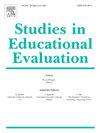Comparing linear and nonlinear reading assessments in PIRLS 2016
IF 2.6
2区 教育学
Q1 EDUCATION & EDUCATIONAL RESEARCH
引用次数: 0
Abstract
Are linear paper-based and nonlinear computer-based reading comprehension measuring the same cognitive constructs? Nonlinear hypertext reading may demand different skills than linear text comprehension, as it requires synthesizing and integrating information from multiple sources. However, research on whether these two forms of comprehension represent distinct constructs remains limited. While conceptual distinctions exist between understanding a single linear text and processing multiple texts, empirical evidence supporting these differences is scarce. To address this gap, we examined the dimensional structure of paper-based linear and computer-based nonlinear text comprehension using data from the PIRLS 2016 international large-scale assessment. PIRLS 2016 evaluated reading comprehension at the end of grade 4, with each student completing both a linear paper-based test and a nonlinear electronic test. Comparing a unidimensional model, a 2-dimensional correlated factor model, and a bifactor IRT model across 16 countries and benchmarking entities showed that the bifactor model, which accommodates a general reading comprehension factor along with nonlinear reading as a specific factor, has a better fit than the other models. The ECVs of the general factor ranged from.80 to.89 across all the countries while the ECVs of the specific factor were between.07 and.18. Nevertheless, the specific factor reliabilities ranged from.36 to.58 which indicates that the variations in the specific factor cannot be just noise and could reflect variations in reading nonlinear texts. These findings revealed that although linear paper-based and nonlinear computer-based reading share a substantial amount of variance, as evidenced by a strong general reading comprehension factor, understanding nonlinear hypertexts requires specific skills that cannot be overlooked and should be explicitly addressed. The implications of the study for the testing and teaching of reading comprehension are discussed.
PIRLS 2016中线性和非线性阅读评估的比较
基于纸张的线性阅读理解和基于计算机的非线性阅读理解测量的是相同的认知结构吗?非线性超文本阅读可能需要不同于线性文本理解的技能,因为它需要综合和整合来自多个来源的信息。然而,关于这两种理解形式是否代表不同构念的研究仍然有限。虽然理解单一线性文本和处理多个文本之间存在概念上的区别,但支持这些差异的经验证据很少。为了解决这一差距,我们使用PIRLS 2016国际大规模评估的数据,研究了基于纸张的线性和基于计算机的非线性文本理解的维度结构。PIRLS 2016评估了四年级结束时的阅读理解能力,每个学生都完成了线性纸上测试和非线性电子测试。通过对16个国家和基准实体的一维模型、二维相关因子模型和双因子IRT模型的比较,发现双因子模型的拟合效果优于其他模型,该模型包含一般阅读理解因子和非线性阅读作为特定因子。一般因素的ecv范围从。80年。而具体因素的ecv则介于两者之间。07年and.18。然而,具体的因素可靠性范围从。36。这表明特定因素的变化不可能仅仅是噪声,而可能反映了阅读非线性文本的变化。这些发现表明,尽管基于纸张的线性阅读和基于计算机的非线性阅读在很大程度上存在差异,但理解非线性超文本需要特定的技能,这些技能不容忽视,应该明确加以解决。本研究对阅读理解的测试和教学具有重要意义。
本文章由计算机程序翻译,如有差异,请以英文原文为准。
求助全文
约1分钟内获得全文
求助全文
来源期刊

Studies in Educational Evaluation
Multiple-
CiteScore
6.90
自引率
6.50%
发文量
90
审稿时长
62 days
期刊介绍:
Studies in Educational Evaluation publishes original reports of evaluation studies. Four types of articles are published by the journal: (a) Empirical evaluation studies representing evaluation practice in educational systems around the world; (b) Theoretical reflections and empirical studies related to issues involved in the evaluation of educational programs, educational institutions, educational personnel and student assessment; (c) Articles summarizing the state-of-the-art concerning specific topics in evaluation in general or in a particular country or group of countries; (d) Book reviews and brief abstracts of evaluation studies.
 求助内容:
求助内容: 应助结果提醒方式:
应助结果提醒方式:


